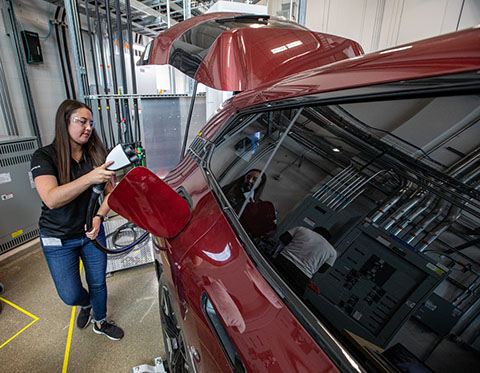Behind-the-Meter Storage Analysis
NLR's behind-the-meter storage (BTMS) analysis aims to lower operational costs and minimize grid impacts of energy-intensive industries with integrated energy systems tailored to meet building demands.

NLR's behind-the-meter storage analysis research focuses on technologies that minimize the costs and grid impacts of electrification for consumers by balancing peak energy demands, integrating EV chargers, and generating electricity on-site. Photo by Werner Slocum, NLR
NLR's analysis experts work alongside the BTMS Consortium to develop technologies for stationary applications that optimize buildings and high-power electric vehicle (EV) charging systems, reduce costs associated with installation and use, and increase the resilience of high energy demand systems.
BTMS analysis plays a crucial role in these projects by visualizing energy flows by comparing potential trade-offs between system upgrades, such as battery and thermal energy storage footprint, photovoltaic (PV) generation, EV charging or building energy demands, and use of grid energy. These models inform component developments and optimize system designs for different climates, building types, and utility rate structures.
In addition, NLR researchers explore how BTMS systems impact stakeholders at all scales to advance nationwide industrial efficiency goals. Using NLR's flagship BTMS tool, EDGES: Enabling Distributed Generation Energy Storage Model, analysts work with businesses and industry partners to design optimal, cost-effective BTMS solutions tailored to specific sites.
Behind-the-Meter Storage Benefits Energy Resilience
Several fundamental and watershed changes in the transportation, electrical, and building sectors are happening simultaneously. Understanding the intersection of these changes is essential for optimizing the benefits of BTMS systems.
Featured Tool
- Buildings must serve significantly more energy needs—such as grid services, EV charging, electric generation, space conditioning, energy storage, and resiliency—than before.
- Increasing energy demands could have significant impacts on grid infrastructure and buildings operations.
- High penetration of solar PV generation installed on buildings is leading to new challenges for building interactions with the power grid.
- Energy storage costs are rapidly declining, enabling greater use of domestic energy sources.
A BTMS system provides energy directly to homes and businesses without passing through an electric meter or interacting with the electric grid. The system acts as a load during a battery's charging period and as a generator during discharging periods. As a result, BTMS systems can help manage demand charges, provide continuous energy supply during power outages, enable EV fast charging, and more.
Featured Projects
In 2019, the Army successfully deployed a behind-the-meter battery energy storage system (BTM BESS) at Fort Carson. The battery, along with an existing solar photovoltaic system, was dispatched to reduce demand charges and is projected to shave an estimated $500,000 off Fort Carson's utility bill each year. Interested in replicating this success, the Army tasked NLR with identifying additional opportunities across 80 U.S. installations.
To identify sites with high potential for cost-effective deployment of BTM BESS without conducting an in-depth assessment at each one, NLR developed a novel phased analytical approach. This methodology could be applied by other federal agencies and organizations interested in identifying BESS opportunities across a large number of sites.
To learn more, read Behind-the-Meter to Front of the Line: Prioritizing Battery Storage Opportunities Across a Portfolio of Sites, NLR Fact Sheet (2021).
Mounting energy demands and the addition of more EVs to rental car center fleets, taxis, and ground transportation are highlighting the need to upgrade energy infrastructure at U.S. airports. On-site energy generation and BTMS solutions can help airports build additional grid capacity and reduce costs while navigating infrastructure investments with confidence. Using EDGES, NLR partnered with Dallas-Fort Worth International Airport (DFW) to evaluate how BTMS and solar photovoltaic energy generation could reduce the costs of rental EV charging.
NLR has already successfully demonstrated an advanced control method to optimize the operation of DFW's central plant with thermal storage, resulting in considerable savings in power consumption and power demand. Now, using EDGES, NLR identified that adding solar photovoltaic generation and BTMS system options resulted in a 41% reduction in life cycle costs over 20 years compared to a base case without BTMS and solar PV energy resources. That is the equivalent of between $14 and $131 million in cost savings, depending on the EV adoption rate. These savings could be attributed to lower utility costs and a 70% decrease in required electrical distribution infrastructure upgrades.
The methodologies developed will be fine-tuned and de-risked through hardware demonstration and experiments at NLR's ARIES: Advanced Research on Integrated Energy Systems.
As e-commerce continues to grow, parcel delivery companies are considering replacing existing fleets with battery-electric vehicles.
NLR, together with Argonne National Laboratory, is assessing charging requirements (e.g., power demand) and the impacts of various charging management and grid integration strategies for several illustrative sites. Based on the analysis, the laboratories will develop an estimate of energy and power requirements for the U.S. Postal Service fleets, ultimately informing charging strategy recommendations.
Should the U.S. Postal Service choose an electric vehicle design, the impacts to the U.S. power grid would be significant. Follow-up analyses may investigate integrating on-site storage and solar generation.
Integrated Data and Analysis Tools
Bolstered by high-performance supercomputing and innovative data visualization technologies, BTMS researchers leverage an integrated suite of data and analysis tools to design, model, and optimize electric vehicle infrastructure.
EDGES: Enabling Distributed Generation Energy Storage Model
REOPT: Renewable Energy Integration and Optimization
U.S. Department of Energy: OpenStudio
EVI-PRO: Electric Vehicle Infrastructure — Projection Tool
EVI-EnSite: Electric Vehicle Infrastructure — Energy Estimation and Site Optimization Tool
Publications
Check the Storage Stack: Comparing Behind-the-Meter Energy Storage State Policy Stacks in the United States, NLR Technical Report (2022)
An Overview of Behind-the-Meter Solar-Plus-Storage Program Design: With Considerations for India, NLR Technical Report (2022)
Impact of Electrode Thickness and Temperature on the Rate Capability of Li4Ti5O12/LiMn2O4 Cells, Journal of The Electrochemical Society (2021)
An Overview of Behind-The-Meter Solar-Plus-Storage Regulatory Design: Approaches and Case Studies to Inform International Applications, NLR Technical Report (2020)
Contact
Share
Last Updated Dec. 7, 2025

